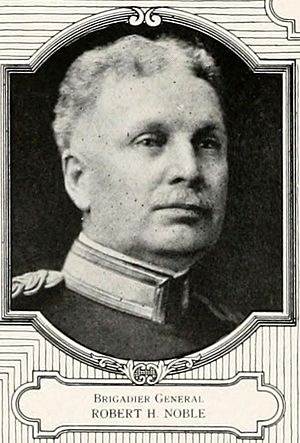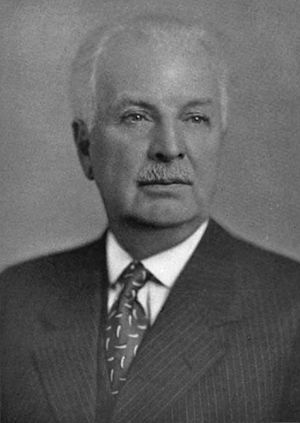Robert Houston Noble facts for kids
Quick facts for kids
Robert Houston Noble
|
|
|---|---|

From 1920's The Official History of the 315th Infantry U.S.A.
|
|
| Born | November 3, 1861 Federalsburg, Maryland, U.S. |
| Died | October 26, 1939 (aged 77) San Francisco, California U.S. |
| Buried | |
| Allegiance | United States |
| Service/ |
United States Army |
| Years of service | 1884–1922 |
| Rank | |
| Unit | U.S. Army Infantry Branch |
| Commands held | Company D, 1st Infantry Regiment Company B, 1st Infantry Company H, 1st Infantry 3rd Battalion, 1st Infantry 22nd Infantry Regiment 6th Infantry Regiment 30th Division 158th Infantry Brigade Monte Carlo Leave Area |
| Battles/wars | Apache Wars Spanish–American War Philippine–American War Pancho Villa Expedition World War I |
| Awards | Silver Star |
| Alma mater | United States Military Academy University of Maryland School of Law |
| Spouse(s) | Ethel Elizabeth (Dimond) Sherwood (m. 1921-1939, his death) |
Robert Houston Noble (November 3, 1861 – October 26, 1939) was a brave officer who served in the United States Army for many years. He fought in several important conflicts, including the Apache Wars, the Spanish–American War, the Philippine–American War, the Pancho Villa Expedition, and World War I. He rose to the rank of brigadier general, which is a high-ranking officer. He is best known for leading the 158th Infantry Brigade during World War I.
Contents
Early Life and Education
Robert H. Noble was born in Federalsburg, Maryland on November 3, 1861. His parents were Dr. William A. Noble and Mary A. (Houston) Noble. He went to public schools in Carroll County and the State Model School in Trenton, New Jersey.
In 1880, Robert Noble began studying at the United States Military Academy, also known as West Point. He graduated in 1884, ranking 32nd out of 37 students in his class.
Becoming a Military Officer
After graduating from West Point, Noble became a second lieutenant in the 1st Infantry Regiment. He was sent to Fort Bowie and Fort Lowell in Arizona. In 1885 and 1886, he helped in the effort to capture Geronimo during the Apache Wars.
In July 1886, his regiment moved to California. Noble served at Angel Island and later at Benicia Barracks.
Studying Law
In September 1890, Noble was assigned to teach military science at St. John's College in Annapolis, Maryland. While there, he earned a law degree (LL.B.) from the University of Maryland School of Law in 1892. He also received an honorary Master of Arts degree from St. John's in 1894. Even though he could practice law, he chose to continue his military career.
Noble rejoined the 1st Infantry in November 1894. He served in various roles in California, including commanding different companies and becoming the regiment's adjutant (a staff officer who helps the commander). In April 1897, he became an aide-de-camp (a personal assistant) to William Rufus Shafter, who was then in charge of the Department of California.
Serving in the Spanish–American War
When the Spanish–American War began in 1898, William Shafter was chosen to lead the Fifth Army Corps. Noble continued to serve as his aide. During the war, Noble fought in battles around Santiago. He was chosen four times to go into Spanish lines under a flag of truce to negotiate.
After Spain surrendered, the Fifth Corps was stationed in Montauk and Governors Island. Noble continued to help Shafter, working on the official report of the corps' wartime activities.
Service in the Philippine–American War
In January 1899, Noble joined the headquarters staff of the Department of California in San Francisco. He held several important positions there, including judge advocate (a legal officer) and inspector general (an officer who checks on military units).
In September 1899, Noble was sent to the Philippines. He served as an adjutant for different brigades and departments, working with commanders like Frederick Dent Grant and Robert Patterson Hughes. He also served as adjutant for U.S. troops in Cebu.
During his time in the Philippines, Noble took part in military campaigns in Luzon, Panay, and Samar. He also accepted the surrender of several Filipino rebels as a representative for his commander.
Continuing His Military Journey
Noble stayed in the Philippines for several more years. From October 1902 to February 1908, he was a military aide to the Governor-General of the Philippines. This period included the terms of governors like William Howard Taft and Luke Edward Wright. When Taft led a U.S. mission to Japan in 1905, Noble went along as the representative for the Philippine government. He did a similar job when Taft visited Hong Kong in 1907.
In early 1908, when Leonard Wood left the Philippines, Noble went with him on a long trip back to the United States. This trip included visiting military sites and units in places like Singapore, Ceylon, Aden, Egypt, Malta, and several European countries.
Back in the United States
In June 1908, Noble rejoined the 1st Infantry Regiment at Vancouver Barracks, Washington. He took command of the regiment's 3rd Battalion. He served with the 1st Infantry until December 1910, and his duties included inspecting Army sites in Alaska.
From January to August 1911, Noble studied at the Field Officers Course in Fort Leavenworth, Kansas. This course is now known as the United States Army Command and General Staff College. From August 1911 to August 1912, he studied at the United States Army War College.
In late 1912, Noble had a temporary assignment as an umpire during war games in Hawaii. In December 1912, he was assigned to the 12th Infantry at the Presidio of Monterey, California. In February 1913, he was promoted to lieutenant colonel. He then worked in San Francisco, overseeing National Guard matters for the Western Department.
From August 1914 to October 1916, Noble commanded the 22nd Infantry Regiment. This regiment was based in Texas City, Texas, patrolling the U.S.-Mexico border, and later in Arizona. Noble was promoted to colonel in July 1916.
In November 1916, Noble took command of the 6th Infantry Regiment. This regiment was stationed in Chihuahua, Mexico, during the Pancho Villa Expedition. He continued to lead the regiment when it moved to Fort Bliss, Texas. Then, he led it to Chickamauga, Georgia, where it trained more to get ready for the U.S. to enter World War I.
World War I Service
The 6th Infantry, part of the 5th Division, arrived in France in March 1918. In April, Noble was promoted to brigadier general. He served with the 30th and 77th Divisions. For a few days, he was even the acting commander of the 30th Division.
After watching British units on the front lines near Albert and Béthune, he served with the 77th Division as an observer in the Baccarat area during the Aisne-Marne Offensive.
In August 1918, Noble was given command of the 158th Infantry Brigade, which was part of the 79th Division. He led his brigade at the start of the Meuse–Argonne offensive. However, he was later removed from command because his division commander and the inspector general were not happy with his performance. Noble was then assigned to staff duty with the AEF Services of Supply. After the war ended in November 1918, Noble went back to his permanent rank of colonel. He commanded the AEF's Monte Carlo Leave Area until February 1919.
Life After the War
In March 1919, Noble returned to the United States. He was put in charge of National Guard affairs for the Ninth Corps Area in San Francisco. He stayed in this job until he retired in December 1922.
After he retired, Noble received the Silver Star medal. This award recognized his bravery during the Siege of Santiago in the Spanish–American War. In 1930, a new law allowed World War I generals to retire at their highest wartime rank. Because of this, Noble was promoted to brigadier general on the Army's retired list.
Retirement and Final Years
In retirement, Noble lived in San Francisco. He was very active in the Episcopal church. He was a member of several church committees and a delegate to church meetings. He was also involved in groups like the Society of Indian Wars, Veterans of the Philippines, and the Military Order of Foreign Wars. Additionally, Noble joined the California Bar Association and the American Bar Association. He also served on the board of directors for the San Francisco chapter of the American Red Cross.
Noble was fluent in Spanish and French. He also composed church music. In retirement, he spent time improving these skills. He passed away in San Francisco on October 26, 1939. Robert Noble was buried at Cypress Lawn Memorial Park in Colma, California.
Family Life
In 1921, Robert Noble married Ethel Elizabeth (Dimond) Sherwood. She was a widow and had two children from her previous marriage: William R. Sherwood II and Beth Sherwood.
Dates of Rank
Here are the dates when Robert Noble received his military ranks:
- Second lieutenant: June 15, 1884
- First lieutenant: June 15, 1891
- Major (temporary): June 20, 1898
- Captain: October 12, 1898
- Major (temporary): September 5, 1899
- Captain: June 30, 1901
- Major: October 4, 1907
- Lieutenant colonel: February 1, 1913
- Colonel: July 1, 1916
- Brigadier general (temporary): April 12, 1918
- Colonel: November 12, 1918
- Colonel (Retired list): December 12, 1912
- Brigadier general (retired list): June 21, 1930
Sources
Books
- Cullum, George Washington (1901). Holden, Edward S.. ed. Biographical Register of the Officers and Graduates of the U.S. Military Academy. Supplement IV. Cambridge, MA: Riverside Press. https://books.google.com/books?id=_5neAAAAMAAJ&pg=PA395.
- Cullum, George Washington (1910). Braden, Charles. ed. Biographical Register of the Officers and Graduates of the U.S. Military Academy. Supplement, Volume V. Saginaw, MI: Seemann & Peters. https://books.google.com/books?id=hMhk8YCF3W8C&pg=PA364.
- Cullum, George Washington (1920). Robinson, Wirt. ed. Biographical Register of the Officers and Graduates of the U.S. Military Academy. Supplement, Volume VI-A. Saginaw, MI: Seemann & Peters. https://books.google.com/books?id=SrdJAQAAMAAJ&pg=PA387.
- Davis, Henry Blaine Jr. (1998). Generals in Khaki. Raleigh, NC: Pentland Press. ISBN 978-1-5719-7088-6. https://books.google.com/books?id=fJvvAAAAMAAJ&q=generals+in+khaki.
- Downs, Winfield Scott, ed. (1941). Encyclopedia of American Biography. N.S., 12. New York, NY: American Historical Company. https://babel.hathitrust.org/cgi/pt?id=mdp.39015059775505&view=1up&seq=841.
- St. John's College (1898). Catalogue of St. John's College, Annapolis, Maryland. Annapolis, MD: Maryland Republican Steam Press. https://books.google.com/books?id=dyxJAQAAMAAJ.
Magazines
- Nenninger, Timothy K. (Spring 2005). "John J. Pershing and Relief for Cause in the American Expeditionary Forces, 1917-1918". Army History (Washington, DC: U.S. Army Center of Military History). https://history.army.mil/armyhistory/AH61newOCR.pdf.
Newspapers
- "Robert H. Noble, Wm. F. Watson and O. F. Hershey". The Baltimore Sun (Baltimore, MD). June 29, 1892. https://www.newspapers.com/clip/72921626/robert-noble/.
- "Funeral Rites Held for Retired General". Oakland Tribune (Oakland, CA): p. 17. October 28, 1939. https://newspaperarchive.com/oakland-tribune-oct-28-1939-p-17/.


